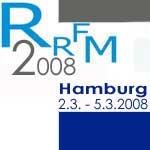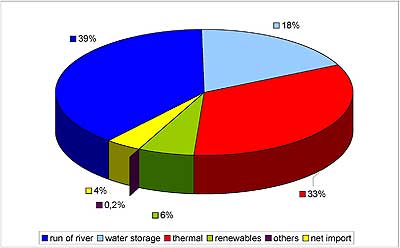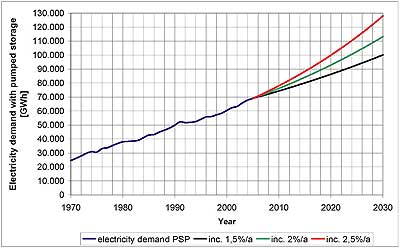 |
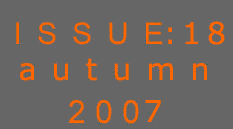 |
Issue No.18 Autumn
|
|
ENS News |
|
ENS Events |
|
Member Societies & Corporate Members |
|
Concept of a future Can Austria Survive Without Nuclear Power? CEA signs European Charter for Researchers and Code of Conduct for the Recruitment of Researchers Croatian conference focuses on nuclear
countries with “small electricity grids.” |
YGN Report |
|
ICEM Conference focuses on training and educating tomorrow’s nuclear sepcialists BNES and Institute of Nuclear Engineers (INucE) organise congress on future of nuclear |
|
European Institutions |
|
ENS World News |
ENS Members |
| Links to ENS Member
Societies Links to ENS Corporate Members Editorial staff ______________________ |
| _____________________ |
| Pime
2008 10 - 14 February 2008 in Prague |
| _____________________ |
____________________ |
 |
____________________ |
|
|
|
Technology |
Power [MWel] |
Fuel |
Efficiency |
pulvericed coal |
750 |
hard coal |
48%, 50%, 52% |
CCT |
750 |
hard coal |
40%, 45% |
GTCC |
400 |
gas |
60%, 65% |
GTCC |
850 |
gas |
60%, 65% |
LWR |
1200 |
UO2 |
35% |
LWR |
1600 |
UO2 |
35% |
Table 1: Used technologies for new power plants in the models
3. RESULTS
As it is not possible to show the results of all scenarios and power plant paths within this paper only the most important results, mainly the nuclear scenarios, are presented here.
3.1 Evolution of the electricity production
Figure 3 shows the results of the power generation mix up to 2030 in the nuclear scenario A02 by fuel. The demand including electricity for pump storage will rise from 57584GWh in 2005 up to 92620GWh in 2030. In this scenario there two GTCC plants are considered, which are actually already under construction and operational in 2008 and 2009. In 2018 the first nuclear plant with 1200MWel will start operation and in 2030 three nuclear power plants with at least 3600MWel will be in operation.
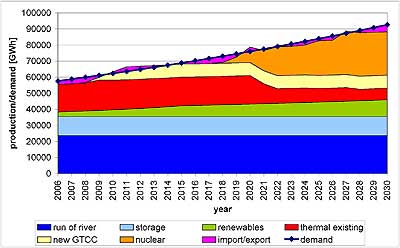
Figure 3: Nuclear scenario A03, increase of demand by 2% per
year (source: own calculation)
The share of nuclear power in electricity production will be 12% in 2020 and 29% in 2030. Hydropower has a share in 2030 of 38%, renewables 11%, existing thermal plants 8%, new GTCC 9% and import 5%.
Figure 4 shows the same picture as in the scenario A03. The main difference is the increasing electricity demand, which is only 1.5% in B03. It starts also from 57584GWh in 2005 and reaches 82316GWh in 2030. As a reason of the lower demand the first nuclear power plant with 1200 MWel start operation not before 2019. In 2030 there are at least two nuclear power plants in operation with together 2400 MWel. The share in electricity production of nuclear power in 2030 will be 21%, hydropower 43%, renewables 11%, existing thermal plants 9%, 10% new GTCC and 6% import.
Compared to the two nuclear scenarios Figure 5 shows the generation mix of the GTCC scenario A01 with an increase of demand of 2% per year.
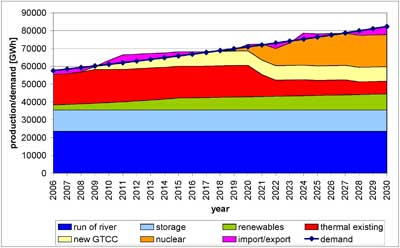
Figure 4: Nuclear scenario B03, increasing of demand
1.5% per year
(source: own calculation)
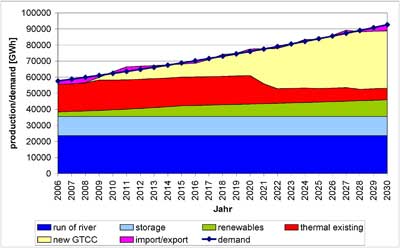
Figure 5: Natural gas scenario A01, increasing of demand 2% per
year
(source: own calculation)
In this scenario all new built power plants use GTCC technology. The generation mix in 2030 consists of 39% new GTCC, 38% hydro, 11% renewable, 8% existing thermal plants and 4% import. A big share (47%) of Austria’s electricity production in 2030 will depend on natural gas because all existing thermal plants at this time use also natural gas as a fuel.
In conclusion it can be stated, that Austria’s electricity production in the future will depend more and more on thermal production either with fossil or nuclear fuels. The share of hydropower will decrease in all scenarios from now 57% to below 45%. Even if the increase in demand is reduced down to 1% or even 0.5% the share of hydropower will be 45% until 50% respectively.
New power plant capacity will be required with at least 2400 MWel or even up to 4600 MWel depending on the selected scenario. These are minimum values because of the assumed high utilization factor of new plants in the calculations. Considering reserve capacity and lower utilization the values of the required new capacity will be much higher.
3.2 Evolution of the fuel demand
Increasing the production of thermal plants with fossil fuels, means also an increase in fuel demand. As mentioned before Austria has very little reserves on fossil fuels. Only 19.7% of the demand of natural gas is produced in Austria. Most of the natural gas in Austria comes from Russia (58.6%), Germany (12.6%) and from Norway (9.1%) [1]. Also the total demand of hard coal has to be imported, mainly from Poland and Czech Republic (88%). Austria also has no reserves of lignite leel. Moreover, lignite has a very low calorific value and high specific CO2-emission. These are the reasons why lignite has not been taken into account for thermal plants in Austria.
Figure 6 shows the evolution of the natural gas consumption in the reference scenario A0. The values are based on 2005. In the GTCC scenario A01 the increase is as expected very strong. It will nearly triple from 3.6 Gm3 to 9.66 Gm3 per year until 2030. In the scenarios A02 with hard coal and A05 with clean coal technologies, where also GTCC technology is used, the increase is not so strong. In A02 the consumption will nearly double to 6.6 Gm3 and in A05 to 6.27 Gm3. In the nuclear scenarios A03 and A04 the consumption of natural gas will shortly increase until 2011 and then drop back to the values of 2005 until 2030.
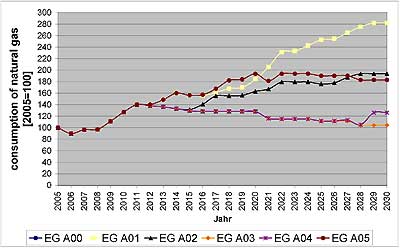
Figure 6: Evolution of the natural gas consumption in Austria up
to 2030 (source: own calculation)

Figure 7: Evolution of the hard coal consumption in Austria up to
2030 (source: own calculation)
In Figure 7 the consumption of (hard coal) in the reference scenario
A0 is shown. As expected the increase of consumption in the coal
scenarios A02 and A05 will be the strongest.
In A05 with clean coal technology the consumption will nearly quadruple, from 1.65 Mt to 6.2 Mt per year in 2030. In A02 it will increase up to 5 Mt in 2030. In the nuclear scenario A03 and in the GTCC scenario A01 the consumption will drop to zero after shutting down the existing plants fired with hard coal in 2021. In the scenario A04 with nuclear power and one new hard coal fired plant the consumption will drop down to 80% of 2005.
The consumption of fossil fuels in the other scenarios (B,C) is equal or slightly lower. It is obvious that more thermal plants (whether natural gas or hard coal fired) will increase the dependence in primary energy supply significantly in the future. The mass flow rates of fossil fuels in the future will, therefore, be very high. This has a negative effect on the security of supply in Austria’s power sector.
For nuclear power plants the consumption is only a few hundred tons of natural uranium per year. Uranium is also a wide spread all over the world and in stable political regions. Thus uranium has two advantages compared to natural gas and hard coal in Austria:
-
The mass flow rate of uranium is much lower.
-
The storage possibility of uranium fuel even for several years is very simple and needs little space
3.3 Evolution of Green house gas emissions
Another important point is the evolution of the green house gas emissions in Austria’s power sector. Austria signed the Kyoto Protocol and committe to reducing green house gas emissions (mainly CO2-emissions) to 13% based on 1990 level. The base for the CO2-emissions in 1990 of the power sector is 10.89 Mt and Austria’s commitment is to reduce these emissions to 9.47 Mt until 2012. The share of the power sector of the totally CO2-emissions in Austria is 14%.
Figure 8 shows the evolution of the CO2-emissions in the reference scenario A0. The magenta line is the base of 1990 and the green line the aim of the reduction (9.47Mt). The strongest increase is in the hard coal scenario A02. The emissions in this scenario will more then double from 11.3 Mt in 2005 to 23 Mt in 2030. There is also a strong increase in the GTCC scenario A01. The CO2-emissions in this scenario will increase up to 16.2 Mt in 2030. In the clean coal and nuclear coal scenarios A05 and A04 the emissions will increase until 2021 by up to 13.15 Mt. After shutting down the existing coal fired thermal plants the CO2-emissions will drop down to the level of 1990. Only in the nuclear scenario will the emissions drop down below the level of the Kyoto target. The emissions in this scenario are 6.1 Mt in 2030.
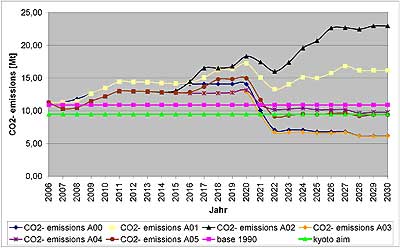
Figure 8: Evolution of the CO2-emissions in Austria
up to 2030
(source: own calculation)
The other scenarios show similar values of CO2-emissions. In the scenario B with lower increase in demand the CO2-emissions are also lower, but nevertheless they are above the base of 1990 and the Kyoto target (except nuclear scenario B03/B13). Concluding this section, the CO2-emissions in the power sector will increase in all scenarios except in the nuclear and energy saving scenario.
4. CONCLUSION
In summary, the analysis has shown that there is a great requirement for new power plant capacity in the future in Austria, to satisfy increasing electricity demand. Another result of the analysis is that the future of the Austrian power sector leads either to thermal production or to increased imports. Hydropower and renewables have very little potential to satisfy future electricity demand. Direct import of electricity leads straight to dependence on foreign imports for electricity supply, because there is no possibility to store electricity in big quantities.
Concerning the thermal production, the only two options are fossil fuels or nuclear power. As shown above nuclear power can fulfil all the requirements to satisfy the future electricity demand both in view of security of supply and reduction of CO2-emissions.
The need for fossil fuels like natural gas or hard coal will increase in all scenarios (except nuclear) and, therefore, primary energy imports will too. It is difficult and expensive to store natural gas in big quantities. So the excessive increase in gas consumption will also lead in strong dependence of foreign countries and has therefore negative effects on guarantee of supply. Concerning CO2-emissions the nuclear scenarios are the only one which can fulfil the Kyoto aims of Austria. In all fossil scenarios the CO2-emissions will more than double according to the Kyoto aims. There is only one non nuclear scenario which can reach the Kyoto aims if the increase of electricity demand is reduced to about 0.5% per year.
If Austria wants to continue to act as a model state of clean environment in Central Europe it should reverse its anti-nuclear policy to meet the future challenges in the power sector.
REFERENCES
[1] E-Control GmbH, www.e-control.at.
[2] G. Brauner, “Entwicklung der österreichischen Erzeugungskapazitäten bis 2015“, Int. Energiewirtschaftliche Tagung IEWT), Vienna 2005.
[3] R. Haas, “Perspektiven der österreichischen Stromversorgung im liberalisierten Strommarkt“, Int. Energiewirtschaftliche Tagung IEWT), Vienna 2005.
[4] S. Böhmer et al., “Stand der Technik bei kalorischen Kraftwerken und Referenzanlagen in Österreich“, Umweltbundesamt, Wien 2003.
[5] K. Kugeler, P. W. Philippen, Energietechnik, Springer, Berlin, 1990.
| |

